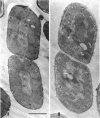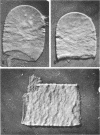Abstract
Hexachlorophene is a soap-compatible bisphenol that has been widely used as an antiseptic, yet its mechanism of action is undefined. The relative threshold concentration for bactericidal effect on a susceptible test organism, Bacillus megaterium, was established to be about 10 μg/mg of cell dry weight. At this or at high (≥100 μg/mg) concentration, adsorptive uptake by cells displayed saturation kinetics. At about 30 μg/mg, the time course of adsorption occurred in three distinct stages. The triphasic pattern was interpreted to represent successive penetration of and adsorption by the cell wall, the protoplast membrane, and the cytoplasm. This interpretation was substantiated by determinations of hexachlorophene adsorption by isolated cell components. Electron microscopy disclosed cytopathology, evidenced as gaps or discontinuities, in the protoplast membrane (but not in the cell wall or cytoplasm) at > 30 μg of hexachlorophene per mg of cell dry weight. Similarly, treatment with > 30 μg/mg allowed a fluorescigenic dye (tolyl-peri acid) to penetrate into the protoplast. However, no detectable cytological manifestations were discerned at the minimum lethal concentration of 10 μg/mg. Apparently, hexachlorophene is physically disruptive at intermediate or high relative concentrations but acts in a more subtle fashion at the minimal lethal concentration.
Full text
PDF
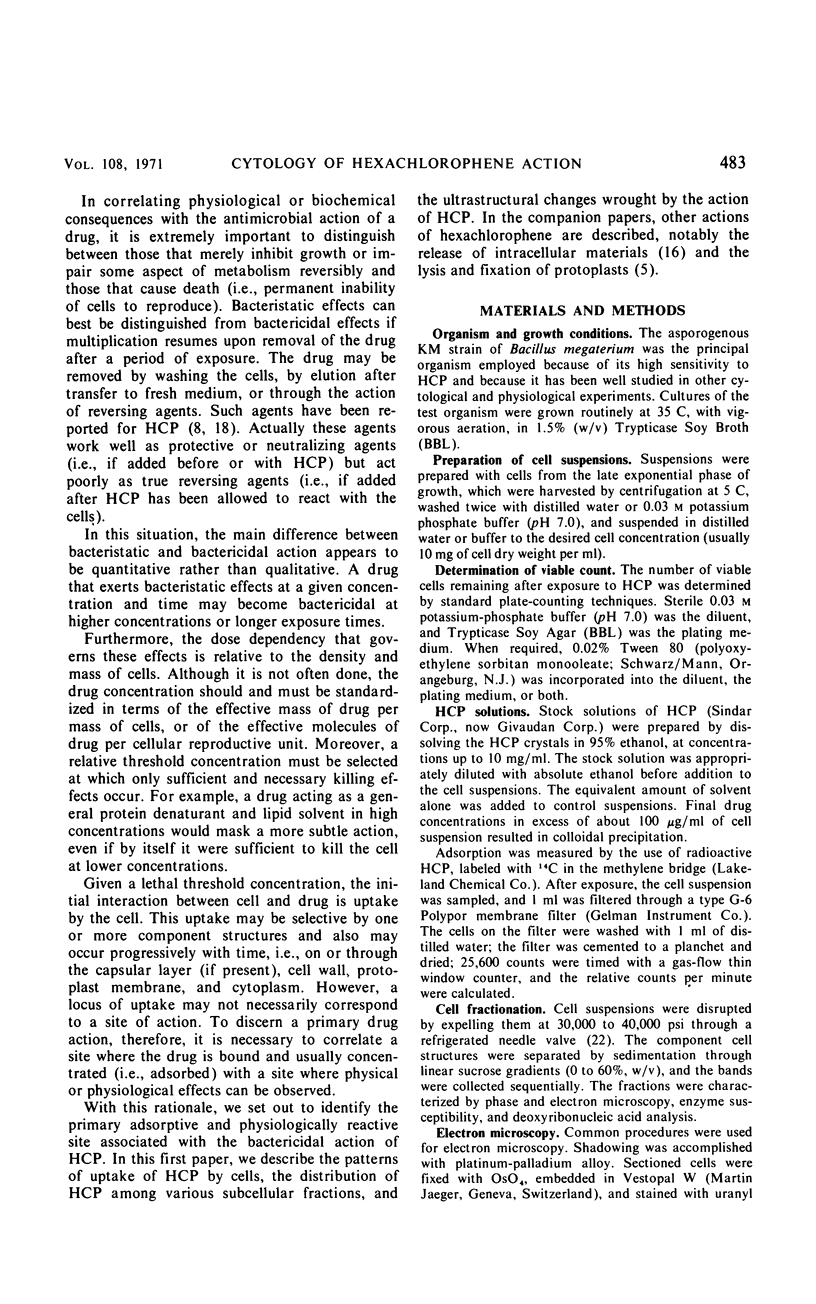
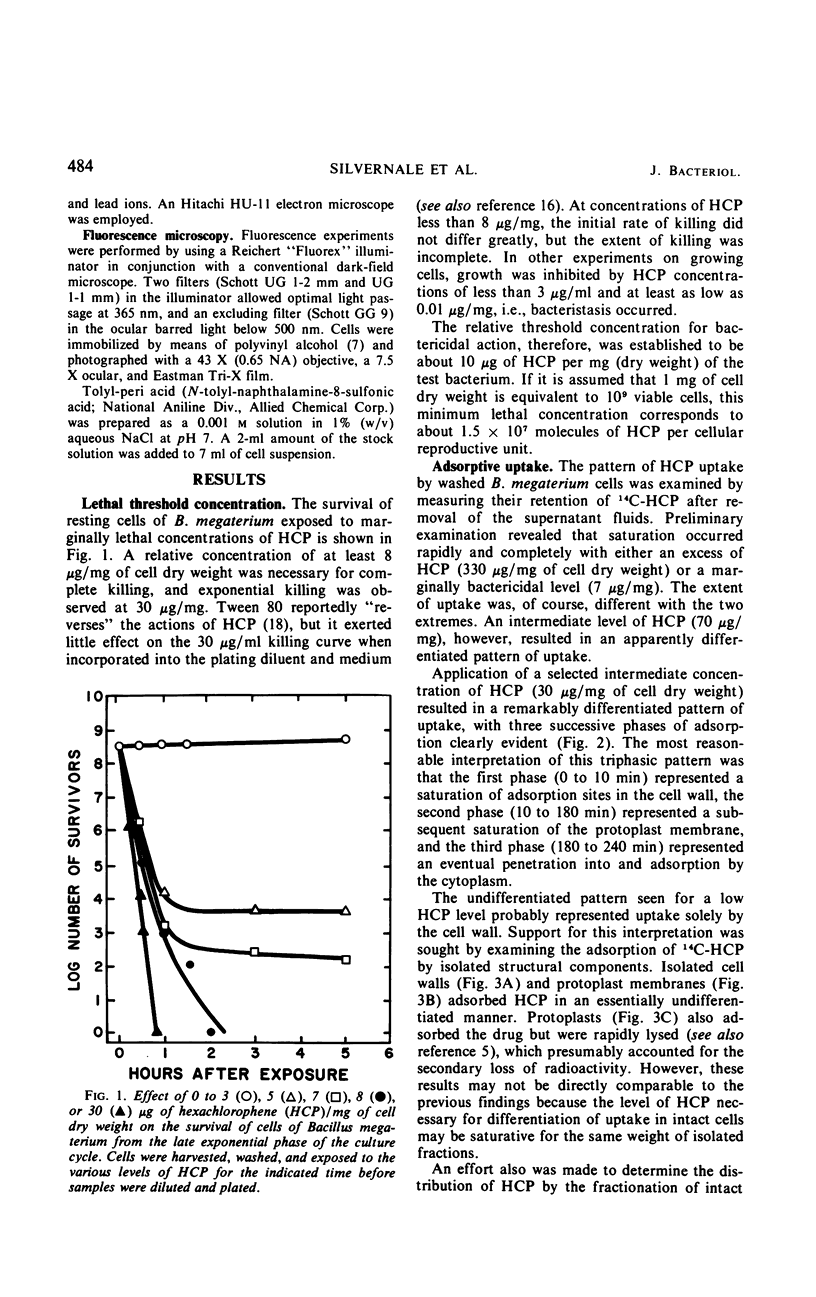


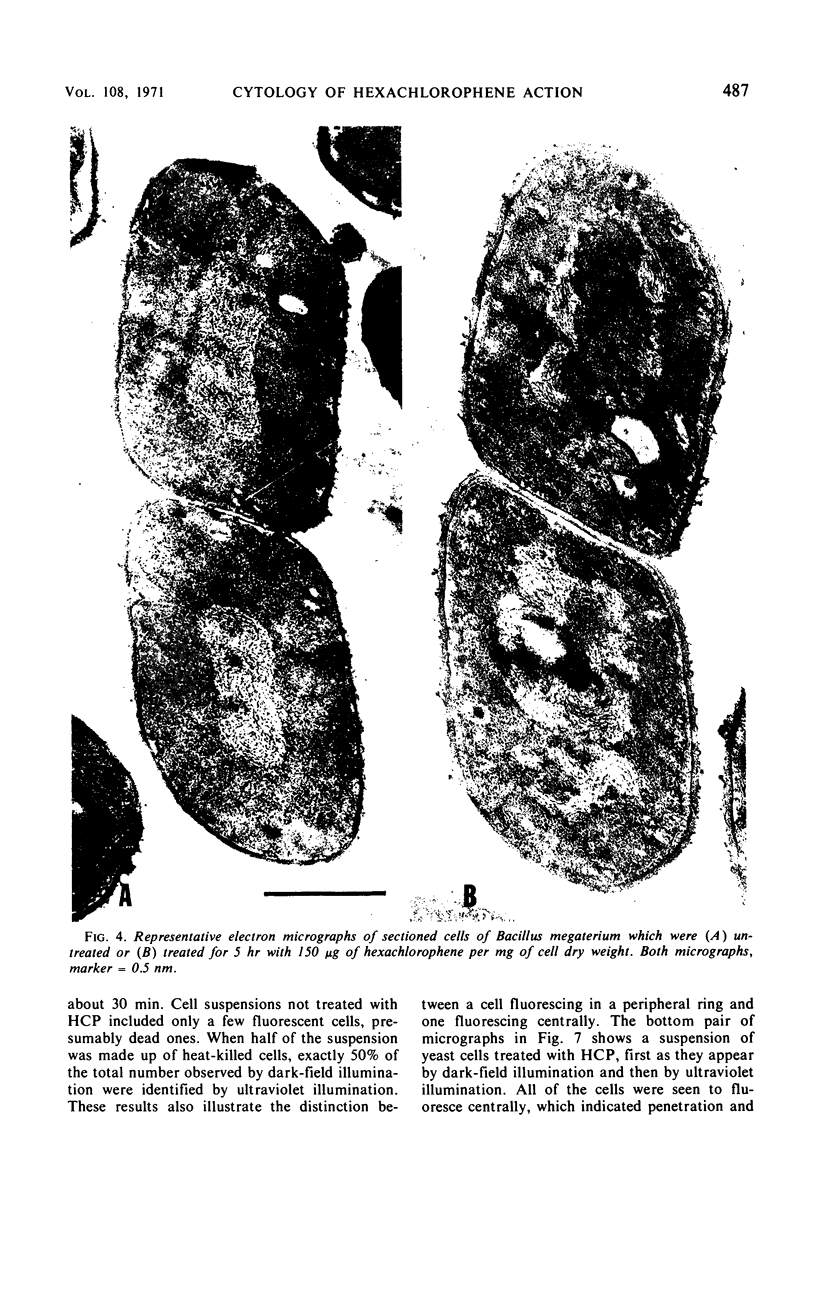
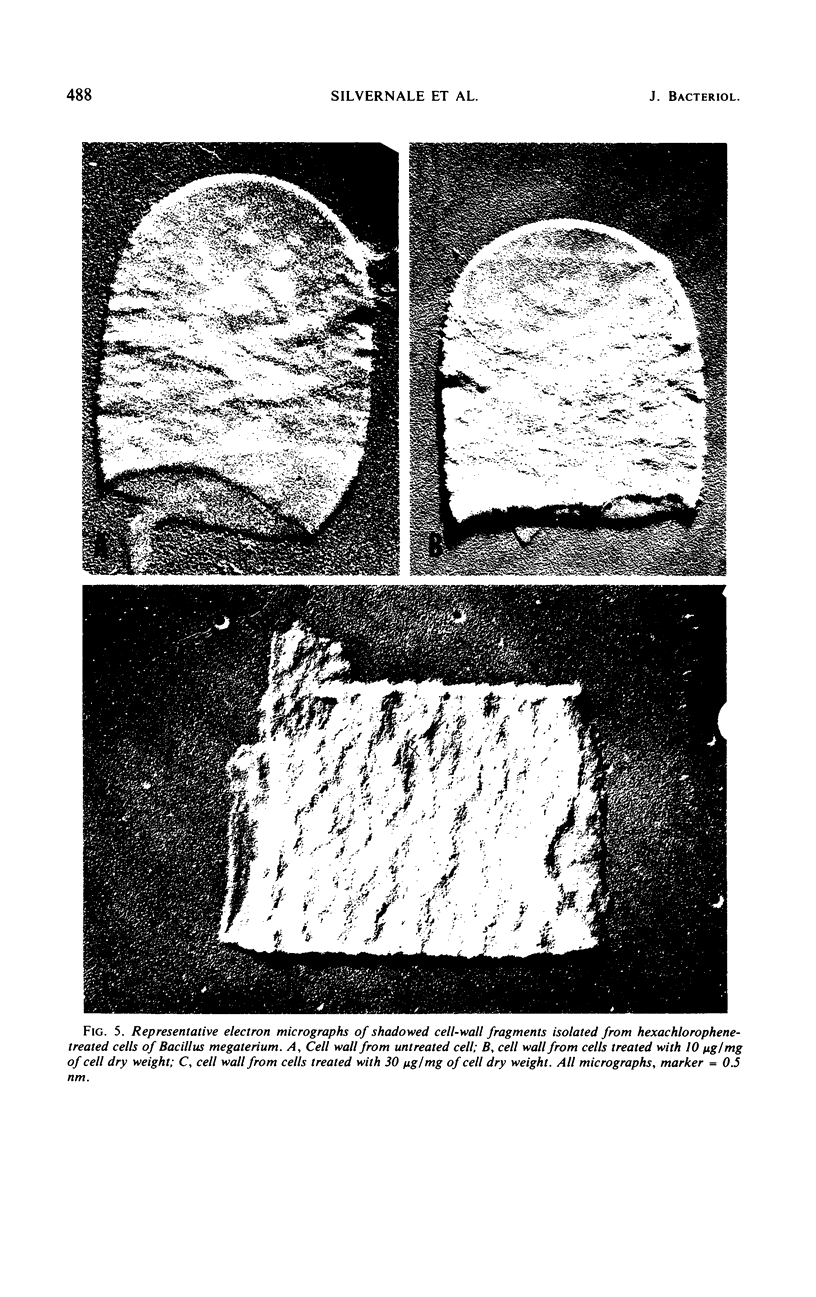

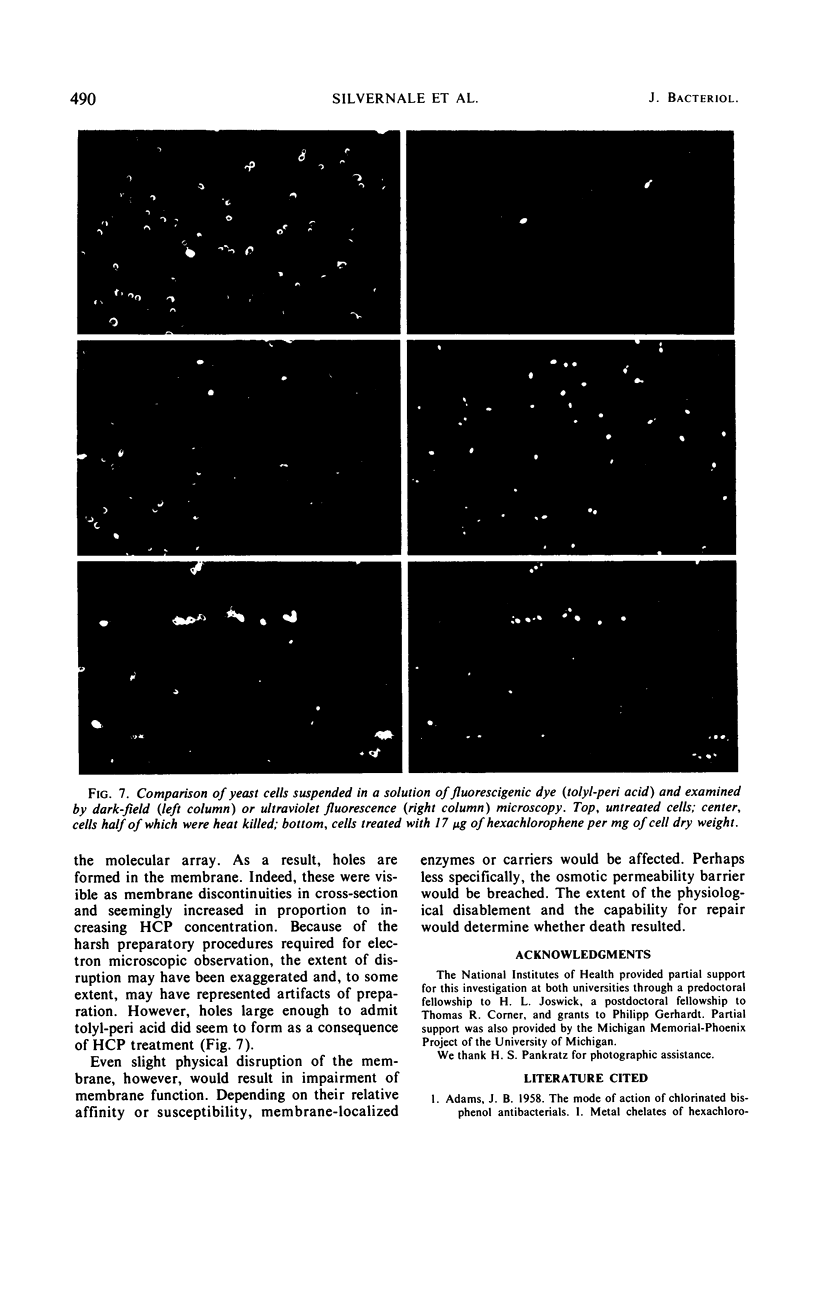

Images in this article
Selected References
These references are in PubMed. This may not be the complete list of references from this article.
- ADAMS J. B., HOBBS M. The mode of action of chlorinated bisphenol antibacterials. II. Biological studies. J Pharm Pharmacol. 1958 Aug;10(8):516–521. doi: 10.1111/j.2042-7158.1958.tb10336.x. [DOI] [PubMed] [Google Scholar]
- ADAMS J. B. The mode of action of chlorinated bisphenol antibacterials. I. Metal chelates of hexachlorophene and thiobisdi-chlorphenol. J Pharm Pharmacol. 1958 Aug;10(8):507–515. doi: 10.1111/j.2042-7158.1958.tb10335.x. [DOI] [PubMed] [Google Scholar]
- ANAND N., DAVIS B. D., ARMITAGE A. K. Uptake of streptomycin by Escherichia coli. Nature. 1960 Jan 2;185:23–24. doi: 10.1038/185023a0. [DOI] [PubMed] [Google Scholar]
- Bayer M. E. Areas of adhesion between wall and membrane of Escherichia coli. J Gen Microbiol. 1968 Oct;53(3):395–404. doi: 10.1099/00221287-53-3-395. [DOI] [PubMed] [Google Scholar]
- Corner T. R., Joswick H. L., Silvernale J. N., Gerhardt P. Antimicrobial actions of hexachlorophene: lysis and fixation of bacterial protoplasts. J Bacteriol. 1971 Oct;108(1):501–507. doi: 10.1128/jb.108.1.501-507.1971. [DOI] [PMC free article] [PubMed] [Google Scholar]
- Cox W. A. Site of action of certain antibacterial heterocyclic quaternary ammonium compounds. Appl Microbiol. 1965 Nov;13(6):956–966. doi: 10.1128/am.13.6.956-966.1965. [DOI] [PMC free article] [PubMed] [Google Scholar]
- EPSTEIN H. T., BOY DE LA TOUR E., SCHIFF J. A. Fluorescence studies of chloroplast development in Euglena. Nature. 1960 Mar 19;185:825–826. doi: 10.1038/185825a0. [DOI] [PubMed] [Google Scholar]
- ERLANDSON A. L., Jr, LAWRENCE C. A. Inactivating medium for hexachlorophene (G11) types of compounds and some substituted phenolic disinfectants. Science. 1953 Sep 4;118(3062):274–276. doi: 10.1126/science.118.3062.274. [DOI] [PubMed] [Google Scholar]
- GOULD B. S., BOSNIAK M. A., NEIDLEMAN S., GATT S. Effect of hexachlorophene and related bisphenolic compounds on the dehydrogenases and cytochrome system of Bacillus subtilis and Escherichia coli. Arch Biochem Biophys. 1953 Jun;44(2):284–297. doi: 10.1016/0003-9861(53)90046-0. [DOI] [PubMed] [Google Scholar]
- GOULD B. S., FRIGERIO N. A., LEBOWITZ W. B. The action of bisphenolic compounds on succinoxidase, cytochrome C oxidase and lactic dehydrogenase of animal tissue. Arch Biochem Biophys. 1955 Jun;56(2):476–486. doi: 10.1016/0003-9861(55)90268-x. [DOI] [PubMed] [Google Scholar]
- Hugo W. B. The mode of action of antibacterial agents. J Appl Bacteriol. 1967 Apr;30(1):17–50. doi: 10.1111/j.1365-2672.1967.tb00273.x. [DOI] [PubMed] [Google Scholar]
- Joswick H. L., Corner T. R., Silvernale J. N., Gerhardt P. Antimicrobial actions of hexachlorophene: release of cytoplasmic materials. J Bacteriol. 1971 Oct;108(1):492–500. doi: 10.1128/jb.108.1.492-500.1971. [DOI] [PMC free article] [PubMed] [Google Scholar]
- Jungermann E. Soap bacteriostats. J Am Oil Chem Soc. 1968 May;45(5):345–350. doi: 10.1007/BF02667108. [DOI] [PubMed] [Google Scholar]
- LAWRENCE C. A., ERLANDSON A. L., Jr A new inactivating medium for hexachlorophene (G-11). J Am Pharm Assoc Am Pharm Assoc. 1953 Jun;42(6):352–357. doi: 10.1002/jps.3030420612. [DOI] [PubMed] [Google Scholar]
- NEWTON B. A. Site of action of polymyxin on Pseudomonas aeruginosa: antagonism by cations. J Gen Microbiol. 1954 Jun;10(3):491–499. doi: 10.1099/00221287-10-3-491. [DOI] [PubMed] [Google Scholar]
- NORMAN A. G. Action of hexachlorophene on plant roots. Antibiot Chemother. 1960 Nov;10:675–681. [PubMed] [Google Scholar]
- RIBI E., PERRINE T., LIST R., BROWN W., GOODE G. Use of pressure cell to prepare cell walls from Mycobacteria. Proc Soc Exp Biol Med. 1959 Mar;100(3):647–649. doi: 10.3181/00379727-100-24730. [DOI] [PubMed] [Google Scholar]
- Rogers H. J. Bacterial growth and the cell envelope. Bacteriol Rev. 1970 Jun;34(2):194–214. doi: 10.1128/br.34.2.194-214.1970. [DOI] [PMC free article] [PubMed] [Google Scholar]
- Taylor G. F. Survival of gram-negative bacteria on plastic compounded with hexachlorophene. Appl Microbiol. 1970 Jan;19(1):131–133. doi: 10.1128/am.19.1.131-133.1970. [DOI] [PMC free article] [PubMed] [Google Scholar]



